Static Electricity
It was discovered centuries ago that certain types of
materials would mysteriously attract one another after being
rubbed together. For example: after rubbing a piece of silk
against a piece of glass, the silk and glass would tend to
stick together. Indeed, there was an attractive force that
could be demonstrated even when the two materials were
separated:
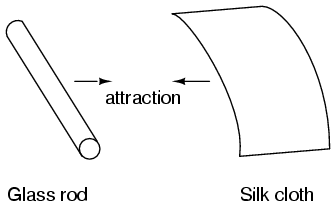
Glass and silk aren't the only materials known to behave
like this. Anyone who has ever brushed up against a latex
balloon only to find that it tries to stick to them has
experienced this same phenomenon. Paraffin wax and wool
cloth are another pair of materials early experimenters
recognized as manifesting attractive forces after being
rubbed together:
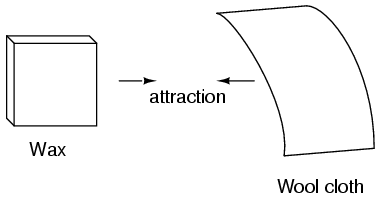
This phenomenon became even more interesting when it was
discovered that identical materials, after having been
rubbed with their respective cloths, always repelled each
other:
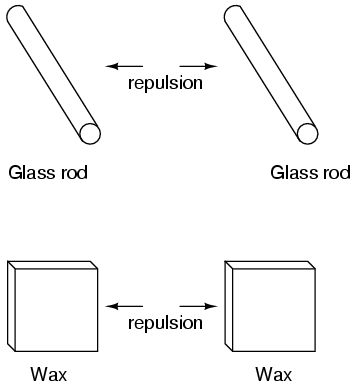
It was also noted that when a piece of glass rubbed with
silk was exposed to a piece of wax rubbed with wool, the two
materials would attract one another:
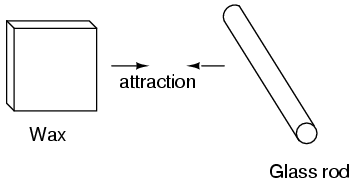
Furthermore, it was found that any material demonstrating
properties of attraction or repulsion after being rubbed
could be classed into one of two distinct categories:
attracted to glass and repelled by wax, or repelled by glass
and attracted to wax. It was either one or the other: there
were no materials found that would be attracted to or
repelled by both glass and wax, or that reacted to one
without reacting to the other.
More attention was directed toward the pieces of cloth
used to do the rubbing. It was discovered that after rubbing
two pieces of glass with two pieces of silk cloth, not only
did the glass pieces repel each other, but so did the
cloths. The same phenomenon held for the pieces of wool used
to rub the wax:
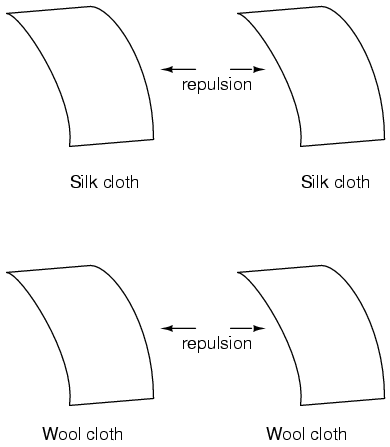
Now, this was really strange to witness. After all, none
of these objects were visibly altered by the rubbing, yet
they definitely behaved differently than before they were
rubbed. Whatever change took place to make these materials
attract or repel one another was invisible.
Some experimenters speculated that invisible "fluids"
were being transferred from one object to another during the
process of rubbing, and that these "fluids" were able to
effect a physical force over a distance. Charles Dufay was
one the early experimenters who demonstrated that there were
definitely two different types of changes wrought by rubbing
certain pairs of objects together. The fact that there was
more than one type of change manifested in these materials
was evident by the fact that there were two types of forces
produced: attraction and repulsion. The
hypothetical fluid transfer became known as a charge.
One pioneering researcher, Benjamin Franklin, came to the
conclusion that there was only one fluid exchanged between
rubbed objects, and that the two different "charges" were
nothing more than either an excess or a deficiency of that
one fluid. After experimenting with wax and wool, Franklin
suggested that the coarse wool removed some of this
invisible fluid from the smooth wax, causing an excess of
fluid on the wool and a deficiency of fluid on the wax. The
resulting disparity in fluid content between the wool and
wax would then cause an attractive force, as the fluid tried
to regain its former balance between the two materials.
Postulating the existence of a single "fluid" that was
either gained or lost through rubbing accounted best for the
observed behavior: that all these materials fell neatly into
one of two categories when rubbed, and most importantly,
that the two active materials rubbed against each other
always fell into opposing categories as evidenced by
their invariable attraction to one another. In other words,
there was never a time where two materials rubbed against
each other both became either positive or negative.
Following Franklin's speculation of the wool rubbing
something off of the wax, the type of charge that was
associated with rubbed wax became known as "negative"
(because it was supposed to have a deficiency of fluid)
while the type of charge associated with the rubbing wool
became known as "positive" (because it was supposed to have
an excess of fluid). Little did he know that his innocent
conjecture would cause much confusion for students of
electricity in the future!
Precise measurements of electrical charge were carried
out by the French physicist Charles Coulomb in the 1780's
using a device called a torsional balance measuring
the force generated between two electrically charged
objects. The results of Coulomb's work led to the
development of a unit of electrical charge named in his
honor, the coulomb. If two "point" objects
(hypothetical objects having no appreciable surface area)
were equally charged to a measure of 1 coulomb, and placed 1
meter (approximately 1 yard) apart, they would generate a
force of about 9 billion newtons (approximately 2 billion
pounds), either attracting or repelling depending on the
types of charges involved.
It discovered much later that this "fluid" was actually
composed of extremely small bits of matter called
electrons, so named in honor of the ancient Greek word
for amber: another material exhibiting charged properties
when rubbed with cloth. Experimentation has since revealed
that all objects are composed of extremely small
"building-blocks" known as atoms, and that these
atoms are in turn composed of smaller components known as
particles. The three fundamental particles comprising
atoms are called protons, neutrons, and
electrons. Atoms are far too small to be seen, but if we
could look at one, it might appear something like this:
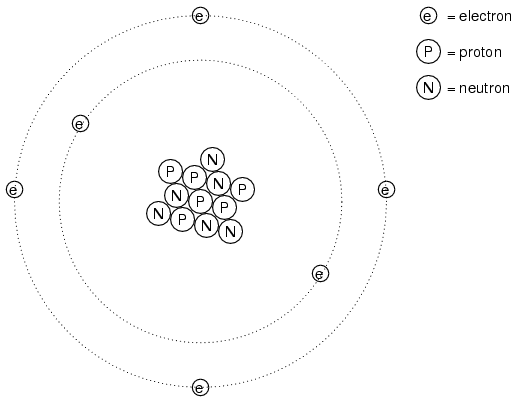
Even though each atom in a piece of material tends to
hold together as a unit, there's actually a lot of empty
space between the electrons and the cluster of protons and
neutrons residing in the middle.
This crude model is that of the element carbon, with six
protons, six neutrons, and six electrons. In any atom, the
protons and neutrons are very tightly bound together, which
is an important quality. The tightly-bound clump of protons
and neutrons in the center of the atom is called the
nucleus, and the number of protons in an atom's nucleus
determines its elemental identity: change the number of
protons in an atom's nucleus, and you change the type of
atom that it is. In fact, if you could remove three protons
from the nucleus of an atom of lead, you will have achieved
the old alchemists' dream of producing an atom of gold! The
tight binding of protons in the nucleus is responsible for
the stable identity of chemical elements, and the failure of
alchemists to achieve their dream.
Neutrons are much less influential on the chemical
character and identity of an atom than protons, although
they are just as hard to add to or remove from the nucleus,
being so tightly bound. If neutrons are added or gained, the
atom will still retain the same chemical identity, but its
mass will change slightly and it may acquire strange
nuclear properties such as radioactivity.
However, electrons have significantly more freedom to
move around in an atom than either protons or neutrons. In
fact, they can be knocked out of their respective positions
(even leaving the atom entirely!) by far less energy than
what it takes to dislodge particles in the nucleus. If this
happens, the atom still retains its chemical identity, but
an important imbalance occurs. Electrons and protons are
unique in the fact that they are attracted to one another
over a distance. It is this attraction over distance which
causes the attraction between rubbed objects, where
electrons are moved away from their original atoms to reside
around atoms of another object.
Electrons tend to repel other electrons over a distance,
as do protons with other protons. The only reason protons
bind together in the nucleus of an atom is because of a much
stronger force called the strong nuclear force which
has effect only under very short distances. Because of this
attraction/repulsion behavior between individual particles,
electrons and protons are said to have opposite electric
charges. That is, each electron has a negative charge, and
each proton a positive charge. In equal numbers within an
atom, they counteract each other's presence so that the net
charge within the atom is zero. This is why the picture of a
carbon atom had six electrons: to balance out the electric
charge of the six protons in the nucleus. If electrons leave
or extra electrons arrive, the atom's net electric charge
will be imbalanced, leaving the atom "charged" as a whole,
causing it to interact with charged particles and other
charged atoms nearby. Neutrons are neither attracted to or
repelled by electrons, protons, or even other neutrons, and
are consequently categorized as having no charge at all.
The process of electrons arriving or leaving is exactly
what happens when certain combinations of materials are
rubbed together: electrons from the atoms of one material
are forced by the rubbing to leave their respective atoms
and transfer over to the atoms of the other material. In
other words, electrons comprise the "fluid" hypothesized by
Benjamin Franklin. The operational definition of a coulomb
as the unit of electrical charge (in terms of force
generated between point charges) was found to be equal to an
excess or deficiency of about 6,250,000,000,000,000,000
electrons. Or, stated in reverse terms, one electron has a
charge of about 0.00000000000000000016 coulombs. Being that
one electron is the smallest known carrier of electric
charge, this last figure of charge for the electron is
defined as the elementary charge.
The result of an imbalance of this "fluid" (electrons)
between objects is called static electricity. It is
called "static" because the displaced electrons tend to
remain stationary after being moved from one material to
another. In the case of wax and wool, it was determined
through further experimentation that electrons in the wool
actually transferred to the atoms in the wax, which is
exactly opposite of Franklin's conjecture! In honor of
Franklin's designation of the wax's charge being "negative"
and the wool's charge being "positive," electrons are said
to have a "negative" charging influence. Thus, an object
whose atoms have received a surplus of electrons is said to
be negatively charged, while an object whose atoms
are lacking electrons is said to be positively
charged, as confusing as these designations may seem. By the
time the true nature of electric "fluid" was discovered,
Franklin's nomenclature of electric charge was too well
established to be easily changed, and so it remains to this
day.
- REVIEW:
- All materials are made up of tiny "building blocks"
known as atoms.
- All atoms contain particles called electrons,
protons, and neutrons.
- Electrons have a negative (-) electric charge.
- Protons have a positive (+) electric charge.
- Neutrons have no electric charge.
- Electrons can be dislodged from atoms much easier than
protons or neutrons.
- The number of protons in an atom's nucleus determines
its identity as a unique element.
|